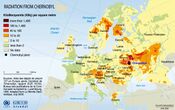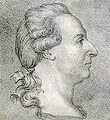Are You Sure? (nonfiction): Difference between revisions
No edit summary |
No edit summary |
||
| Line 15: | Line 15: | ||
<span style="font-weight:bold">Are You Sure ... (April 28, 2020)</span> | <span style="font-weight:bold">Are You Sure ... (April 28, 2020)</span> | ||
• ... that logician, mathematician, and analytic philosopher '''[[Kurt Gödel (nonfiction)|Kurt Gödel]]''' (1906–1978) shocked his colleagues with his [[Gödel's incompleteness theorems|incompleteness theorems]], which use [[Mathematical logic (nonfiction)|mathematical logic]] itself to prove that mathematical logic (which might be thought of as the science of being certain) is inherently subject to uncertainty; that Gödel's work shook mathematics to its [[Foundations of mathematics (nonfiction)|foundations]], establishing fundamental principles of modern thought; and that Gödel suffered periods of mental instability and illness, with an obsessive fear of being poisoned, eventually eating only food that his wife, Adele, prepared for him; and that after her | • ... that logician, mathematician, and analytic philosopher '''[[Kurt Gödel (nonfiction)|Kurt Gödel]]''' (1906–1978) shocked his colleagues with his [[Gödel's incompleteness theorems|incompleteness theorems]], which use [[Mathematical logic (nonfiction)|mathematical logic]] itself to prove that mathematical logic (which might be thought of as the science of being certain) is inherently subject to uncertainty; that Gödel's work shook mathematics to its [[Foundations of mathematics (nonfiction)|foundations]], establishing fundamental principles of modern thought; and that Gödel suffered periods of mental instability and illness, with an obsessive fear of being poisoned, eventually eating only food that his wife, Adele, prepared for him; and that after her hospitalization in 1977, when she could no longer prepare her husband's meals, he starved to death? | ||
• ... that physicist and engineer '''[[Rolf Landauer (nonfiction)|Rolf Landauer]]''' (1927–1999) made important contributions to the thermodynamics of information processing, including the principle that in any logically irreversible operation that manipulates information, such as erasing a bit of memory, [[Entropy (nonfiction)|entropy]] increases and an associated amount of energy is dissipated as heat, a phenomenon now known as [[Landauer's principle (nonfiction)|Landauer's principle]]? | • ... that physicist and engineer '''[[Rolf Landauer (nonfiction)|Rolf Landauer]]''' (1927–1999) made important contributions to the thermodynamics of information processing, including the principle that in any logically irreversible operation that manipulates information, such as erasing a bit of memory, [[Entropy (nonfiction)|entropy]] increases and an associated amount of energy is dissipated as heat, a phenomenon now known as [[Landauer's principle (nonfiction)|Landauer's principle]]? | ||
Revision as of 12:07, 28 April 2020
Are You Sure? is a feature of the Gnomon Chronicles.
See also Are You Sure? (archive) (nonfiction)
Work in progress
April 28
GNOMON CHRONICLES

The text under the complete photograph reads:
"Adele Porkert and Gödel were an unlikely but devoted couple. This photograph, taken at an outdoor Viennese cafe, is from the period of their long courtship. Porkert shielded Gödel from the worst of his irrational fears, and was often the only person who could persuade him to eat. More than anyone else, she was responsible for keeping him alive and productive."
After his wife's hospitalization in 1977, Gödel stopped eating and starved to death.
Are You Sure ... (April 28, 2020)
• ... that logician, mathematician, and analytic philosopher Kurt Gödel (1906–1978) shocked his colleagues with his incompleteness theorems, which use mathematical logic itself to prove that mathematical logic (which might be thought of as the science of being certain) is inherently subject to uncertainty; that Gödel's work shook mathematics to its foundations, establishing fundamental principles of modern thought; and that Gödel suffered periods of mental instability and illness, with an obsessive fear of being poisoned, eventually eating only food that his wife, Adele, prepared for him; and that after her hospitalization in 1977, when she could no longer prepare her husband's meals, he starved to death?
• ... that physicist and engineer Rolf Landauer (1927–1999) made important contributions to the thermodynamics of information processing, including the principle that in any logically irreversible operation that manipulates information, such as erasing a bit of memory, entropy increases and an associated amount of energy is dissipated as heat, a phenomenon now known as Landauer's principle?
• ... that geometrical frustration (or simply frustration) is a phenomenon in condensed matter physics where atoms tend to stick to non-trivial positions or where, on a regular crystal lattice, conflicting inter-atomic forces (each one favoring rather simple, but different structures) lead to quite complex structures, and that as a consequence of the frustration in the geometry or in the forces, a plenitude of distinct ground states may result at zero temperature, and usual thermal ordering may be suppressed at higher temperatures?
• ... that mathematician Leopold Kronecker (1823–1891) was quoted by Heinrich Martin Weber (1893): "Die ganzen Zahlen hat der liebe Gott gemacht, alles andere ist Menschenwerk" ("God made the integers, all else is the work of man")?
April 27
GNOMON CHRONICLES

—John Ehrlichman, White House counsel and presidential aide, quoted in "Legalize it all", Harper's Magazine, April 2016.
Are You Sure ... (April 27, 2020)
• ... that former White House counsel and Presidential aide John D. Ehrlichman (b. 1925) was released from an Arizona prison on this day in 1978 after serving eighteen months for Watergate-related crimes?
• ... that painter and inventor Samuel Morse (1791–1872) met artist and pioneering photographer Louis Daguerre in 1839 while visiting Paris, and that Morse become interested in the daguerreotype (the first practical means of photography), writing a letter to the New York Observer describing the invention; and that Mathew Brady, one of the earliest photographers in American history, famous for his depictions of the American Civil War, studied under Morse and later took photographs of him?
• ... that mathematician Paul Gordan (1837–1912) encouraged fellow mathematician David Hilbert and used Hilbert's results and methods, and the widespread story that Gordon opposed David Hilbert's work on invariant theory is a myth, although Gordon did correctly point out in a referee's report that some of the reasoning in Hilbert's paper was incomplete; and that Gordon is famously quoted (or misquoted — it is not clear if Gordan really said this, nor is it clear whether the quote was intended as criticism, or praise, or a subtle joke) as saying of Hilbert's proof of Hilbert's basis theorem: "This is not mathematics; this is theology."?
• ... that a nomogram (from Greek νόμος nomos, "law" and γραμμή grammē, "line"), also called a nomograph, alignment chart, or abaque, is a graphical calculating device consisting of a set of two or more scales (one for each variable in an equation), and a straight line (either drawn or virtual) called an index line or isopleth, which is drawn across the scales; and that (1) knowing the values of all but one variable, the value of the unknown variable can be found, and (2) by fixing the values of some variables, the relationship between the unfixed ones can be studied?
• ... that physicist and space activist Gerard K. O'Neill (1927–1992) graduated from high school in 1944, then enlisted in the United States Navy on his 17th birthday, and that the Navy trained O'Neill as a radar technician, sparking his interest in science?
• ... that biochemist and crystallographer John Kendrew (1917–1997) investigated the structure of heme-containing proteins, sharing the 1962 Nobel Prize for chemistry with Max Perutz for determining the atomic structures of proteins using X-ray crystallography; and that Kendrew's initial source of raw material for myoglobin was horse heart, but the myoglobin crystals thus obtained were too small for X-ray analysis so Kendrew then used whale meat, reasoning that the oxygen-conserving tissue of diving mammals could contain larger crystals?
• ... that the Fugu squash is a genetically engineered hybrid of the fugu fish and any of various types of squash, and that it was created as a vegan delicacy for high-end sushi restaurants?
• ... that author, mathematician, scientist, political activist, and educator Irving Adler (1913–2012) turned his attention, in the late 1970s, to the question of phyllotaxis, specifically to the arrangement of plant spirals according to the Fibonacci sequence, and that his papers in the Journal of Theoretical Biology stimulated a revival of interest in the subject?
April 26
GNOMON CHRONICLES

Contamination from the Chernobyl disaster was scattered irregularly depending on weather conditions, much of it deposited on mountainous regions such as the Alps, the Welsh mountains and the Scottish Highlands, where adiabatic cooling caused radioactive rainfall. The resulting patches of contamination were often highly localized, and water-flows across the ground contributed further to large variations in radioactivity over small areas. Sweden and Norway also received heavy fallout when the contaminated air collided with a cold front, bringing rain. There was also groundwater contamination.
Are You Sure ... (April 26, 2020)
• ... that the Chernobyl disaster began on Saturday 26 April 1986 with an uncontrolled nuclear chain reaction caused by a combination of unstable conditions and reactor design flaws; and that the chain reaction rapidly released of a large amount of energy which vaporized superheated cooling water, ruptured the reactor core in a highly destructive steam explosion, and ignited an open-air reactor core fire; and that airborne radiation contaminated parts of the USSR and western Europe?
• ... that the United States detonated the Castle Union nuclear test weapon on April 26, 1954 at Bikini atoll in the Marshall Islands, leaving a crater 910 meters in diameter and 27 meters deep; that sixty-seven nuclear weapons were detonated in the Marshalls over twelve years; and that just one of over sixty islands has been cleaned by the US government, and that the inhabitants of the Marshalls are still waiting for the two billion dollars in compensation assessed by the Nuclear Claims Tribunal, and that many of the islanders and their descendants still live in exile, as the islands remain contaminated with high levels of radiation?
• ... that philosopher Edmund Husserl (1859–1938) established phenomenology as school of thought; that in his early work, he elaborated critiques of historicism and of psychologism in logic based on analyses of intentionality; and that in his mature work, Husserl developed a systematic foundational science based on phenomenological reduction, arguing that transcendental consciousness sets the limits of all possible knowledge?
• ... that physician Jean François Fernel (1497–1558) suggested that taste buds are sensitive to fat, an idea which research in the early 21st Century proved to be correct?
On This Day
GNOMON CHRONICLES
On This Day in History and Fiction: April 18
1796: Physicist Johan Carl Wilcke dies. Wilcke invented the electrophorus, and calculated the latent heat of ice.
1873: Chemist and academic Justus von Liebig dies. Von Liebeg made pioneering contributions to organic chemistry, especially agricultural and biological chemistry; he is known as the "Father of the fertilizer industry".
1907: Jazz drummer and theoretical physicist Albert Einstein hosts an all-star benefit concert to raise money for the rebuilding of San Francisco.
1955: Physicist, engineer, and academic Albert Einstein dies. Einstein developed the theory of relativity, one of the two pillars of modern physics (alongside quantum mechanics).
2011: Mathematician Curt Meyer dies. Meyer made notable contributions to number theory, including an alternative solution to the class number 1 problem, building on the original Stark–Heegner theorem.





